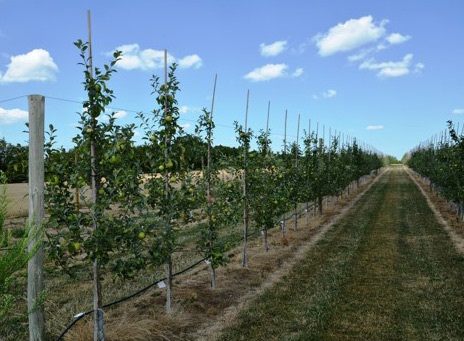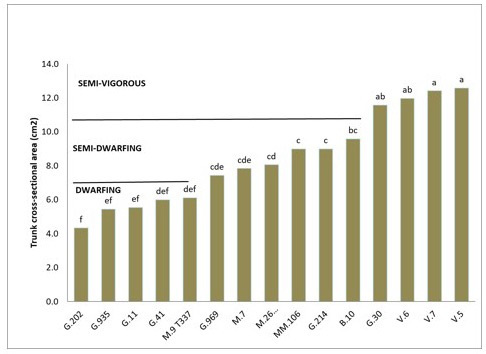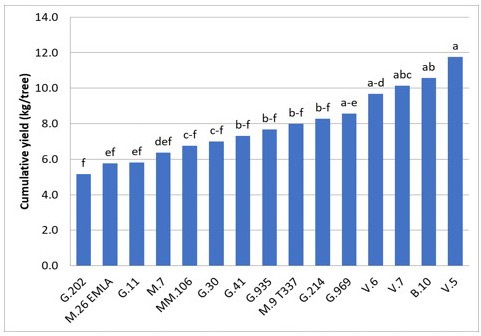Update on rootstocks for Honeycrisp apples
Learn about research findings for rootstocks that can be used with honeycrisp apples.
When establishing new orchards or replanting old ones, apple growers must consider the cultivar and rootstock combination one to two years prior to planting, depending on the method of propagation and availability of rootstocks. Rootstock choice is important as it can have profound economic and orchard management consequences. There are currently a great number of rootstocks being promoted, however, some may not be suitable for your orchard because of soil, climate, cultivar combination or orchard system being established.
The pomology research program at the University of Guelph, Simcoe Research Station has been actively involved in long-term rootstock research to determine the size, disease susceptibility and adaptability of a number of rootstocks from around the world. The information gathered from these experiments, some affiliated with the NC-140 technical committee, is extremely useful in determining the environment-genetic interactions rootstocks have on yield, precocity, tree performance, longevity, resistance to disease and winter injury, and tendency to sucker. This article will provide an update on some of our most recent results from studies conducted on Honeycrisp and will briefly review some commercially available apple rootstocks.
A brief review
Malling 9 (M.9) rootstock is one of the original Malling series of size-controlling rootstocks developed in Great Britain at East Malling Research Station earlier in the 1900s. M.9 is internationally recognized for being a superior dwarfing rootstock for apples. Despite being susceptible to fireblight and woolly apple aphid, it is very resistant to collar rot, produces few suckers, maintains good fruit size, and is extremely productive and precocious. A virus-free clone of M.9, denoted by the industry as M.9 EMLA or M.9 E, was developed by heat treatment. The M.9 E virus-free clone is approximately 30% smaller than M.26 E (i.e. tree size for M.26 E=100, M.9 E=70) and 25% larger than the original M.9. Many sub-clones or strains of M.9 exist today and are either the result of further heat treatment to destroy viruses or selections made by nurseries for ease of stool bed propagation. M.9 clones vary slightly in their degree of dwarfing imparted to the scion, however, all remain more vigorous than M.27 E and less vigorous than M.26 E. Generally, clones that are less vigorous than M.9 E include M.9 Flueren 56 and M.9 NAKB T337 while those that more vigorous than M.9 E are M.9 Pajam 1, M.9 RN29 and M.9 Pajam2 (Table 1). Please note that the names of some of these may vary by the jurisdiction. Overall, NC-140 studies conducted throughout North America indicate that M.9 clones vary in size by about ± 20% when compared to M.9 E.
| Rootstock (in ascending order of vigour) | Sub-clone | Other name(s) | Origin |
|---|---|---|---|
| M.27 | N/A | N/A | Britain |
| M.9 — Less vigorous to more vigorous | M.9 Flueren 56 | N/A | N/A |
| M.9 — Less vigorous to more vigorous | M.9 NAKB T337 | N/A | Netherlands |
| M.9 — Less vigorous to more vigorous | M.9 E(MLA) | N/A | England |
| M.9 — Less vigorous to more vigorous | M.9 RN 29 | M.9 Nicolai M.9 RN (René Nicolai) | Belgium |
| M.9 — Less vigorous to more vigorous | M.9 Pajam 1 | Lancep | France |
| M.9 — Less vigorous to more vigorous | M.9 Pajam 2 | Cepiland | France |
| M.26 E | N/A | N/A | Britain |
| M.4 | N/A | Dutch Doucin, Holstein Doucin | Britain |
The height of the bud union at planting can have a greater influence on the tree than differences among M.9 clones. By adjusting the height of the union from the soil line, growers can also manipulate dwarfing characteristics of the rootstock. In general, there is a 10% reduction in tree size for every incremental 10 cm of height that the graft union is placed above the soil line.
Research objectives
- Increased production efficiency through the development of new high-density precocious orchard systems that intercept more light and produce a greater percentage of target fruit with the goal of reducing grower cost of production (for example, labour-saving technologies).
- Science-based apple rootstock evaluation for Ontario's unique growing regions.
Methods
Ten Honeycrisp trees on each of fifteen different rootstocks (B.10, G.11, G.202, G.214, G.30, G.41, G.935, G.969, M.26 EMLA, M.7, MM.106, M.9 T337, V.5, V.6, and V.7) were planted in the spring of 2014 at the University of Guelph, Simcoe Research Station. Ten trees of each rootstock were planted using a 'tall spindle' system at a 1.2 x 3.6 m spacing (2342 trees/ha) according to a completely randomized design with single trees serving as experimental units. Pollinizer trees were placed uniformly throughout the planting. Trees are trickle irrigated with 2 L/hr pressure compensating emitters and scheduled to deliver approximately 25 mm of water per week. At planting, initial trunk diameter was measured 30 cm above the graft union and the number of side branches >10 cm were counted. Annually, the following are being recorded: trunk circumference in the fall of each year to gauge tree vigour, tree status at the end of each growing season, the number of root suckers per tree, as well as total number and weight of fruit harvested.
Trees established well, however initial size varied by rootstock as some trees were better branched/feathered and had more extensive root systems than others. For example, at planting, there were significantly more branches on V.5, V.6, and V.7 as well as G.214 when compared with the other rootstocks. This might have been more a function of nursery propagation technique (tissue culture vs. stool bed rootstock) than of rootstock directly.
Results
Tree vigour
The rootstock ranking of tree vigour in 2017 was very similar to previous years. Trees on V.5, V.7, and V.6 remained the most vigorous (12.6, 12.4, and 12.0 cm2 TCSA, respectively) while G.202 and G.935 remained the least vigorous (4.3 and 5.4 cm2 TCSA, respectively) (Figure 2). Growth of trees on MM.106 and M.7 was very similar to the standard M.26. The growth and performance of M.26 has been atypically poor and should be considered when comparisons are made with M.26 in this experiment.
Yield
Statistically significant rootstock effects on yield were observed among trees grown on the various rootstocks. Cumulative yields of the three Vineland series rootstocks as well as B.10 have been the greatest, while G.202 has been the lowest (Figure 3). Additionally, MM.106 and M.7 were also two of the lowest yielding rootstocks, producing 6.8 and 6.4 kg of fruit per tree, respectively over the past two years, compared to V.5, which produced 11.8 kg per tree over the same period.
Cumulative yield efficiency, which normalized yield based on tree size (TCSA), was significant among rootstocks. G.935, M.9 T337 and G.202 had the highest yield efficiency while MM.106, M.26, and G.30 had the lowest of the fifteen rootstocks. No rootstock effects on average fruit weight were detected in 2017 (data not shown).
Suckering
Rootstock suckering has been minimal on all of the rootstocks.
Tree mortality
At the end of the 2014 growing season, the year of planting, tree mortality was 20% for G.41, 10% for G.935, and 12% for V.7.Since then, there has been no further mortality on these three rootstocks and no mortality on any of the other rootstocks.
Other notes
In August 2017, several Honeycrisp trees on G.202 and fewer on G.935 showed signs of stress with pale yellow leaves and a wilted appearance. The significance of this is unknown, but other reports of virus sensitivity of some Cornell-Geneva rootstocks makes us suspect that it might be playing a role. Close observation of these trees will be made in future years to determine its impact. This effect was unlikely related to drought stress, since all trees have been trickle irrigated.
Overview of several commercially available apple rootstocks
B.10® cv. Mich 96 (Tested as Bud.62396)
- Included in the 2003 NC-140 test.
- Developed in Russia and selected for improved winter-hardiness.
- A 10-year trial with Golden Delicious showed that trees on this rootstock were similar in size to trees on G.935 and M.9 T337 (15% smaller). It has been more vigorous than M.26 in Simcoe.
- Has reportedly wide scaffold branch angles.
- High production efficiency, equal to or greater than M.9 T337.
- Good tree survival.
- A potential substitute for M.9.
B.118
- A cold-hardy rootstock originating from the Minsk breeding program, Russia.
- Tree vigour is approximately 85% the size of seedling.
- Imparts a high degree of winter-hardiness.
- Propagates easily in stool beds and does not sucker.
- Moderately resistant to fireblight but susceptible to Phytophthora.
- Because of its high vigour, it is only recommended for spur strains of apple or in weak soil, weak growing climates or replant situations.
Geneva® 11 'G.11'
- The most common Cornell rootstock that will be initially available.
- Works well on virgin soil but not tolerant to replant disease.
- M.9 size vigor.
- Light rootstock suckering, fireblight resistant, not woolly apple aphid resistant.
Geneva® 41 'G.41'
- Slightly more vigorous than M.9 (similar in size in Simcoe with Honeycrisp as scion).
- Replant, fireblight, and crown rot resistant, little rootstock suckering.
- Graft union prone to breakage, therefore staking is required.
Geneva® 935 'G.935'
- Reportedly M.26 vigour category (but similar to M.9 in Simcoe with Honeycrisp as scion).
- Good for spur type cultivars.
- Replant, fireblight and crown rot resistant.
- Cold-hardy.
- Has reportedly flat branch angles.
- Not woolly apple aphid resistant.
- Has displayed signs of leaf yellowing in Simcoe.
- Sensitive to latent virus which causes tree decline. Be sure scion wood is virus-free.
Geneva® 202 'G.202'
- Reported semi-dwarf rootstock (M.26 size). In Simcoe experiment, less vigorous than M.9 T337 (weakest trees in study).
- Performs well on various soils.
- Has resistance to fireblight, woolly apple aphid and soil replant disease.
- Early yields with Honeycrisp have been poor in Simcoe.
Geneva® 16 'G.16'
- Dwarf rootstock (M.9 size).
- Fireblight resistant with some resistance to soil replant disease.
- Not woolly apple aphid resistant.
- Hypersensitive to at least one latent virus, therefore only virus-free budwood should be used with this rootstock.
- Good mid-winter hardiness, but poor early winter hardiness.
Geneva® 210 'G.210'
- Semi-dwarf rootstock (M.7 size).
- Needs support.
- Displays resistance to fireblight, crown rot and soil replant disease.
- Woolly apple aphid resistant.
- Prone to suckering in NC-140 tests.
Summary
Apple producers have a wide selection of rootstocks to choose from. The decision of rootstock selection should be based on a number of factors including availability of virus-certified trees (rootstock and scion), growing region (hardiness zone), soil fertility, orchard system, cultivar, tree spacing, replant disease, and prevalence of disease. Specific replant disease (SRD) is a 'silent' disorder that appears to affect tree performance and production more than once thought. Planting a more vigorous rootstock with proven performance in SRD sites is a good strategy since few soil fumigants remain available. The range in tree vigour afforded by the various rootstocks in this study provides growers with several planting options based on soil type/vigor, rootstock vigor, and orchard system. There is interest in more vigorous rootstocks in regions where tree growth is limited due to climate, soil, or replant disease. The Vineland series and B.10 look particularly promising in this regard. In cases where a more dwarfing rootstock is desired, G.969 looks both productive and size-controlling and very comparable in vigour to M.9 T337.
Our preliminary results indicate G.935 as a very precocious rootstock in the M.9 size category. V.5, V.6, and V.7 appear to be more vigorous and slightly less yield efficient, but offer cold hardiness and resistance to fireblight (rootstock not scion resistance). M.9 and M.26 remain productive size-controlling stocks with several positive attributes, however their primary weakness is a high susceptibility to fireblight and lack of cold hardiness. In addition, M.26 is prone to fungi in the genus Phytophthora that cause root death and decay.
More information on rootstocks can be found in OMAFRA fact sheet, Apple rootstocks.
Acknowledgements
The technical assistance of Cathy Bakker is gratefully acknowledged.
This project is generously funded through the Canadian Agri-Science Cluster for Horticulture 2, in partnership with Agriculture and Agri-Food Canada's AgriInnovation Program, a Growing Forward 2 initiative, the Canadian Horticultural Council and industry contributors, including the Ontario Apple Growers.


